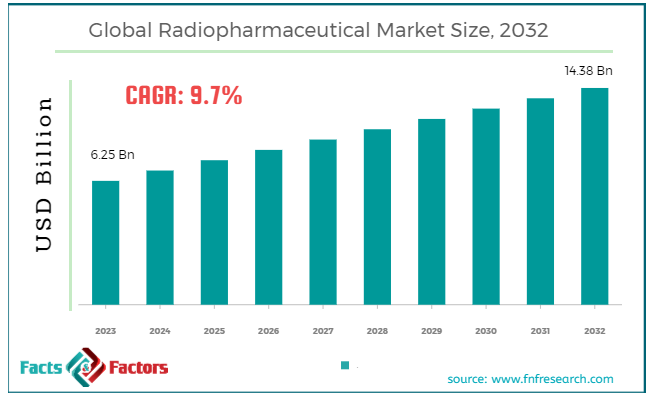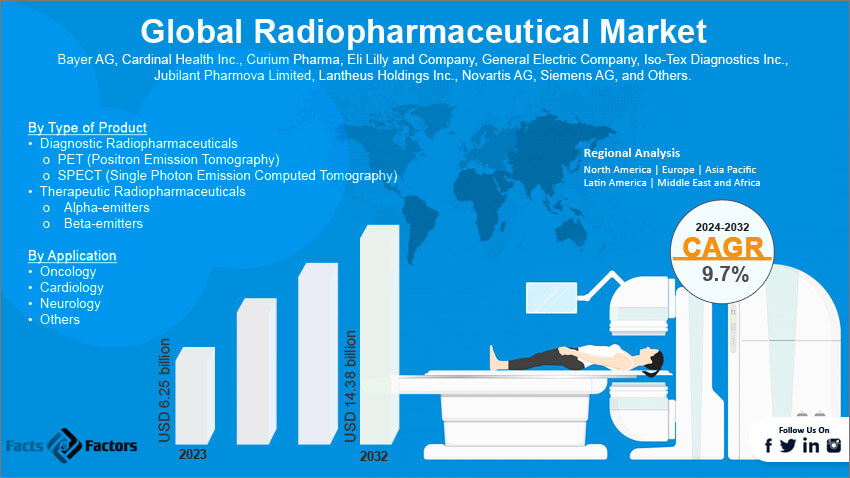Search Market Research Report
Radiopharmaceutical Market Size, Share Global Analysis Report, 2024 – 2032

Radiopharmaceutical Market Size, Share, Growth Analysis Report By Type of Product (Diagnostic Radiopharmaceuticals [PET (Positron Emission Tomography), SPECT (Single Photon Emission Computed Tomography)], Therapeutic Radiopharmaceuticals [Alpha-emitters, Beta-emitters]), By Application (Oncology, Cardiology, Neurology, and Others), By End-User (Hospitals and Diagnostic Centers), And By Region - Global and Regional Industry Insights, Overview, Comprehensive Analysis, Trends, Statistical Research, Market Intelligence, Historical Data and Forecast 2024 – 2032
Industry Insights
[223+ Pages Report] According to Facts & Factors, the global radiopharmaceutical market size in terms of revenue was valued at around USD 6.25 billion in 2023 and is expected to reach a value of USD 14.38 billion by 2032, growing at a CAGR of roughly 9.7% from 2024 to 2032. The global radiopharmaceutical market is projected to grow at a significant growth rate due to several driving factors.

 Market Overview
Market Overview
Radiopharmaceuticals are a group of pharmaceutical drugs that are radioactive. They are used primarily as diagnostic and therapeutic agents. Radiopharmaceuticals contain radionuclides which emit radiation, and they are used to treat conditions or image organs and abnormalities within the body. Radiopharmaceuticals are used for medical purposes in two main ways such as diagnosis and therapeutic applications. Radiopharmaceuticals can be used to image internal organs and identify abnormalities. The radiation emitted by the radiopharmaceutical is detected by special imaging equipment, creating a picture of the targeted area. Common diagnostic procedures using radiopharmaceuticals include PET scans (positron emission tomography) and SPECT scans (single-photon emission computed tomography).
Some radiopharmaceuticals are used to treat conditions such as hyperthyroidism, thyroid cancer, bone pain from cancer, and certain types of blood disorders. They work by delivering radiation specifically to the affected areas, minimizing damage to healthy tissues. The radiopharmaceutical market is characterized by a high degree of innovation and specialization, driven by the critical need for precise and effective medical imaging and therapy solutions. As research progresses and the applications of radiopharmaceuticals expand, the market is expected to grow correspondingly.
 Key Highlights
Key Highlights
- The radiopharmaceutical market has registered a CAGR of 9.7% during the forecast period.
- In terms of revenue, the global radiopharmaceutical market was estimated at roughly USD 6.25 billion in 2023 and is predicted to attain a value of USD 14.38 billion by 2032.
- The radiopharmaceutical market is experiencing steady growth, driven by several key factors such as rising demand for advanced diagnostics, growing geriatric population, and increased healthcare expenditure.
- Based on the Application, the oncology segment is projected to swipe the largest market share.
- Based on the end users, the hospital segment is growing at a high rate and is projected to dominate the global market. In 2022, the hospitals segment produced a 51.85% revenue share.
- By region, North America dominates the global radiopharmaceutical market due to its advanced healthcare systems, high investment in R&D, and the presence of major players in the pharmaceutical industry. However, the Asia-Pacific region is anticipated to experience the highest growth rate, making it a key area for future market expansion.

 Radiopharmaceutical Market Dynamics: A Radioactive Renaissance in Medical Care
Radiopharmaceutical Market Dynamics: A Radioactive Renaissance in Medical Care
The radiopharmaceutical market is undergoing a surge, fueled by a confluence of factors impacting both its necessity and advancement. Here's a breakdown of the key forces shaping this dynamic market:
 Growth Drivers:
Growth Drivers:
- Rising Demand for Advanced Diagnostics: The need for early and accurate disease detection is paramount. Radiopharmaceuticals offer unparalleled capabilities in visualizing internal functions and abnormalities. This translates to a growing demand for PET, SPECT scans, and other procedures utilizing these specialized drugs.
- Aging Population & Chronic Disease Burden: As the global population ages, the prevalence of chronic diseases like cancer is expected to rise significantly. This creates a greater need for diagnostic tools like radiopharmaceuticals used in cancer imaging and treatment monitoring.
- Advancements in Radiopharmaceutical Development: The field is witnessing the development of next-generation radiopharmaceuticals with improved features. These advancements include:
- Targeted Therapies: New radiopharmaceuticals can target diseased cells more precisely, minimizing side effects on healthy tissues.
- Theranostic Applications: Theranostic agents combine diagnostic and therapeutic functions, allowing for disease evaluation and treatment within the same radiopharmaceutical.
 Restraints:
Restraints:
- Short Half-Life of Radioisotopes: The radioactive materials used in radiopharmaceuticals often have short half-lives, meaning their radioactivity diminishes rapidly. This necessitates:
- Just-in-time production and delivery to ensure effectiveness.
- Limited availability in remote areas lacking specialized production facilities.
- High Cost of Development and Production: Developing and producing radiopharmaceuticals requires specialized infrastructure and expertise. This, coupled with stringent regulations, can lead to high costs for these drugs.
- Strict Regulatory Requirements: Due to the use of radioactive materials, radiopharmaceuticals face rigorous safety and efficacy testing before market approval. This can delay the availability of new radiopharmaceuticals for patients.
 Opportunities:
Opportunities:
- Focus on Personalized Medicine: The potential for personalized radiopharmaceuticals tailored to individual patient needs and genetic profiles could revolutionize treatment approaches.
- Emerging Markets with Growing Healthcare Investments: Developing countries with increasing healthcare budgets present significant growth opportunities for the radiopharmaceutical market. This is driven by rising demand for advanced diagnostic tools and treatment options.
- Technological Advancements in Imaging Techniques: Improvements in PET, SPECT, and other imaging equipment can lead to more precise detection of radiopharmaceutical signals. This translates to enhanced diagnostic accuracy and improved patient outcomes.
 Challenges:
Challenges:
- Shortage of Skilled Professionals: The radiopharmaceutical field requires specialized training and expertise in handling radioactive materials. A shortage of skilled professionals in radiopharmacy and nuclear medicine can hinder market growth in certain regions.
- Reimbursement Policies and Affordability: Reimbursement policies by insurance companies may not adequately cover the costs of radiopharmaceutical procedures, limiting patient access to these potentially life-saving tools.
By addressing these dynamics, the radiopharmaceutical market is poised for continued growth. Advancements in technology, development of targeted radiopharmaceuticals, and increasing healthcare investments will fuel market expansion. However, overcoming challenges related to affordability, accessibility, and workforce development will be crucial to ensure equitable access to these powerful tools for improved global healthcare.
 Radiopharmaceutical Market: Segmentation Analysis
Radiopharmaceutical Market: Segmentation Analysis
The radiopharmaceutical market is segmented based on various factors including type of product, application, end-users, and region. Each segment and subsegment provides insights into the scope and dynamics of the market. Here’s a comprehensive segmentation analysis:
 Segmentation Analysis by Type of Product
Segmentation Analysis by Type of Product
Based on Type of Product, the global radiopharmaceutical market is bifurcated into diagnostic radiopharmaceuticals and therapeutic radiopharmaceuticals. The diagnostic Radiopharmaceuticals segment holds the major share due to the rising demand for early and accurate disease detection. A broad range of diagnostic procedures utilizing radiopharmaceuticals like PET scans, SPECT scans, and scintigraphy. Diagnostic Radiopharmaceuticals are further segmented into PET (Positron Emission Tomography), and SPECT (Single Photon Emission Computed Tomography). PET radiopharmaceuticals are expected to show the highest CAGR due to their superior image quality, quantification accuracy, and increasing adoption in neurology and oncology diagnostics. PET radiopharmaceuticals include isotopes such as F-18, which are used in glucose analogs like FDG to image glucose metabolism, commonly used in cancer and brain imaging.
The therapeutic Radiopharmaceuticals segment is experiencing rapid growth fueled by the Development of targeted radiopharmaceuticals that deliver radiation directly to cancer cells. Growing adoption of radiopharmaceutical therapy for specific cancers and other diseases. Therapeutic Radiopharmaceuticals are further divided into Alpha-emitters and Beta-emitters. Beta-emitters are projected to dominate due to their effectiveness in targeted therapy applications, particularly in treating bone metastasis and lymphoma. It includes isotopes like I-131, used in thyroid cancer therapy, and Y-90 used for liver cancer treatment.
 Segmentation Analysis by Application
Segmentation Analysis by Application
Based on Application, the global radiopharmaceutical market is categorized into oncology, cardiology, neurology, and other applications. The oncology segment dominates the application category due to the high prevalence of cancer globally and the effective integration of radiopharmaceuticals in cancer diagnosis and therapy. Radiopharmaceuticals are used for both imaging tumors and delivering targeted radiotherapy to treat various cancers. Cardiology is primarily used in SPECT imaging to assess myocardial perfusion, diagnose coronary artery diseases, and evaluate myocardial infarction.
Neurology drugs help diagnose and assess neurological disorders like Alzheimer's disease and Parkinson's disease. Radiopharmaceuticals also play a role in diagnosing and treating conditions like thyroid disorders, lung diseases, and bone infections.
 Segmentation Analysis by End-User
Segmentation Analysis by End-User
Based on End-User, the global radiopharmaceutical market is categorized into Hospitals and Diagnostic Centers. Hospitals are the primary users of radiopharmaceuticals due to the need for sophisticated imaging equipment and specialized healthcare facilities. Hospitals utilize these compounds for both diagnostic purposes and therapeutic treatments, encompassing a broad range of conditions from cancer to heart disease. Diagnostic Centers focus on the diagnostic applications of radiopharmaceuticals, particularly using PET and SPECT imaging technologies to diagnose various chronic conditions.
 Recent Developments:
Recent Developments:
- Boosting Nuclear Medicine Workforce (March 2023): The International Atomic Energy Agency (IAEA) joined forces with an 11-member consortium in Japan. This collaboration, under the "Rays of Hope" initiative, aims to strengthen the nuclear medicine workforce across Asia and the Pacific. This ensures a skilled workforce to support the growing use of radiopharmaceuticals in the region.
- Focus on Cancer Treatment (January 2023): NorthStar Medical Radioisotopes, a US pharmaceutical company, partnered with Inhibrx, Inc. to co-develop and produce innovative radiopharmaceuticals specifically for cancer treatment. This partnership highlights the growing importance of radiopharmaceuticals in targeted cancer therapies.
- FDA Approval for Lung Imaging (December 2022): Polarean Imaging Plc received FDA approval for Xenoview, a novel diagnostic radiopharmaceutical. Used with MRI scans, Xenoview helps evaluate lung ventilation in a wide range of patients, including children and adults. This approval expands options for non-invasive lung function assessment.
- New Therapy for Advanced Prostate Cancer (March 2022): Pharmaceutical giant Novartis gained FDA approval for Pluvicto, a groundbreaking radiopharmaceutical for treating adults with a specific type of advanced prostate cancer. This approval offers a new treatment option for patients battling this aggressive form of the disease.
 Report Scope
Report Scope
Report Attribute |
Details |
Market Size in 2023 |
USD 6.25 Billion |
Projected Market Size in 2032 |
USD 14.38 Billion |
CAGR Growth Rate |
9.7% CAGR |
Base Year |
2023 |
Forecast Years |
2024-2032 |
Key Market Players |
Bayer AG, Cardinal Health Inc., Curium Pharma, Eli Lilly and Company, General Electric Company, Iso-Tex Diagnostics Inc., Jubilant Pharmova Limited, Lantheus Holdings Inc., Novartis AG, Siemens AG, and Others. |
Key Segment |
By Type of Product, By Application, By End-User, and By Region |
Major Regions Covered |
North America, Europe, Asia Pacific, Latin America, and the Middle East &, Africa |
Purchase Options |
Request customized purchase options to meet your research needs. Explore purchase options |
 Radiopharmaceutical Market: Regional Analysis
Radiopharmaceutical Market: Regional Analysis
North America is a leading region in the radiopharmaceutical market, primarily due to its advanced healthcare infrastructure, high healthcare spending, and the presence of major pharmaceutical and biotechnology companies. In 2022, this region accounted for 43.8% of total revenue. The region has robust regulatory frameworks that facilitate the rapid approval and commercialization of new radiopharmaceuticals. The region exhibits a strong CAGR, driven by widespread clinical applications of radiopharmaceuticals in oncology and cardiology, coupled with high rates of chronic diseases such as cancer.
Europe closely follows North America in the radiopharmaceutical market. It benefits from strong governmental support for healthcare research, well-established nuclear medicine sectors, and extensive healthcare coverage. The presence of key nuclear research institutes and favorable reimbursement policies also contribute to the market growth. The market in Europe shows a robust CAGR, supported by increasing demand for precision medicines and the integration of radiopharmaceuticals in diagnostic practices.
Asia-Pacific is expected to grow at the fastest rate in the radiopharmaceutical market. Factors contributing to this growth include rapidly improving healthcare infrastructure, increasing disposable incomes, and governmental initiatives to modernize healthcare facilities. Countries like China, Japan, and South Korea are at the forefront, with India also showing significant growth potential. The Asia-Pacific market's CAGR is projected to be the highest, driven by rising healthcare standards, an aging population, and the increasing prevalence of cancer and cardiovascular diseases.
The Latin American market is developing, with countries like Brazil and Mexico leading the way. Growth in this region is spurred by improving healthcare infrastructure, rising medical tourism, and gradual increases in healthcare expenditures. Although smaller in scale compared to other regions, Latin America's CAGR is growing steadily as the region adopts more advanced medical technologies and treatments.
The Middle East and Africa region represents a smaller segment of the global market but is expected to expand due to increasing investment in healthcare infrastructure and the untapped potential in the pharmaceutical sector. Countries in the Gulf Cooperation Council (GCC) like Saudi Arabia and the United Arab Emirates are investing heavily in healthcare. The CAGR for the Middle East and Africa is promising, though it starts from a smaller base compared to other regions. The market growth is supported by urbanization, rising health awareness, and government initiatives in healthcare.
 Radiopharmaceutical Market: Competitive Landscape
Radiopharmaceutical Market: Competitive Landscape
Several market companies engaged in the global radiopharmaceutical market include;
- Bayer AG
- Cardinal Health Inc.
- Curium Pharma
- Eli Lilly and Company
- General Electric Company
- Iso-Tex Diagnostics, Inc.
- Jubilant Pharmova Limited
- Lantheus Holdings, Inc.
- Novartis AG
- Siemens AG
The global radiopharmaceutical market is segmented as follows:
 By Type of Product Segment Analysis
By Type of Product Segment Analysis
- Diagnostic Radiopharmaceuticals
- PET (Positron Emission Tomography)
- SPECT (Single Photon Emission Computed Tomography)
- Therapeutic Radiopharmaceuticals
- Alpha-emitters
- Beta-emitters
 By Application Segment Analysis
By Application Segment Analysis
- Oncology
- Cardiology
- Neurology
- Others
 By End-User Segment Analysis
By End-User Segment Analysis
- Hospitals
- Diagnostic Centers
 By Regional Segment Analysis
By Regional Segment Analysis
- North America
- The U.S.
- Canada
- Mexico
- Europe
- France
- The UK
- Spain
- Germany
- Italy
- Rest of Europe
- Asia Pacific
- China
- Japan
- India
- Australia
- Southeast Asia
- Rest of Asia Pacific
- The Middle East & Africa
- Saudi Arabia
- UAE
- Egypt
- Kuwait
- South Africa
- Rest of the Middle East & Africa
- Latin America
- Brazil
- Argentina
- Rest of Latin America
Industry Major Market Players
- Billet Proof Designs
- Schumacher Electric Corporation
- Clore Automotive
- Stanley Black & Decker Inc.
- Antigravity Batteries LLC
- TACKLIFE
- Shenzhen CARKU Technology Co. Ltd
- Boltpower
- Shenzhen Kayo Maxtar Battery Limited
Frequently Asked Questions

Copyright © 2024 - 2025, All Rights Reserved, Facts and Factors


